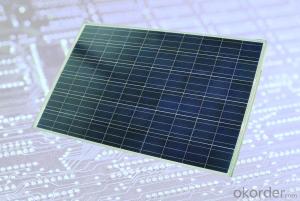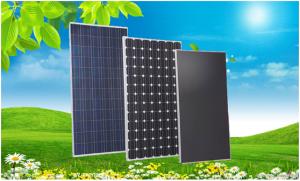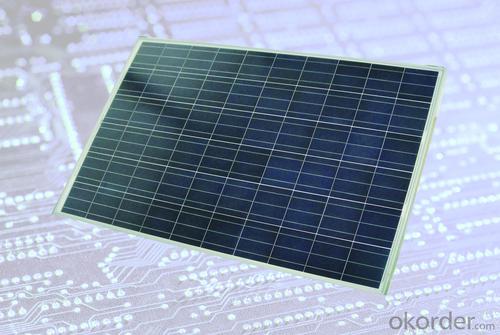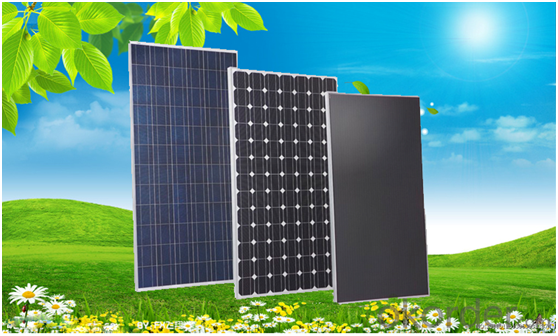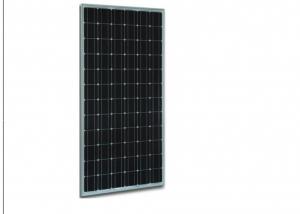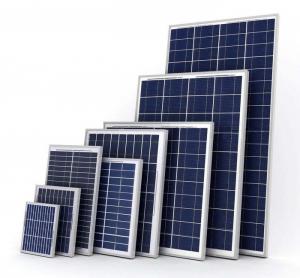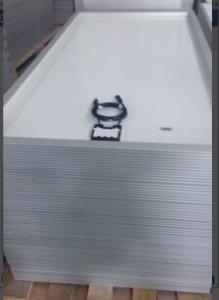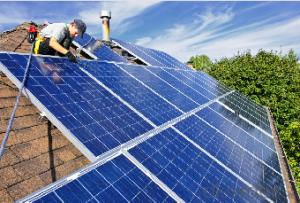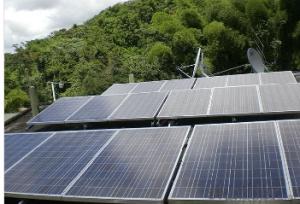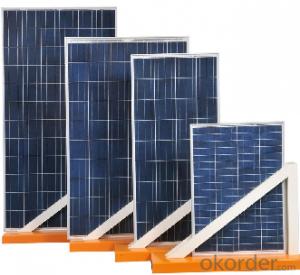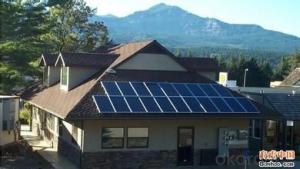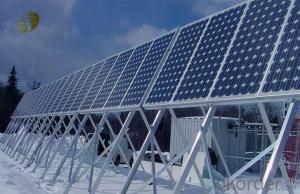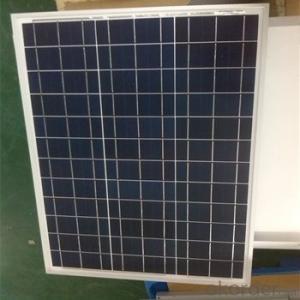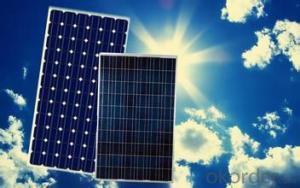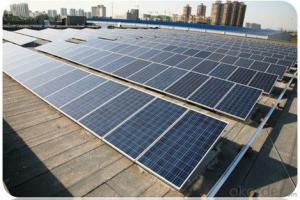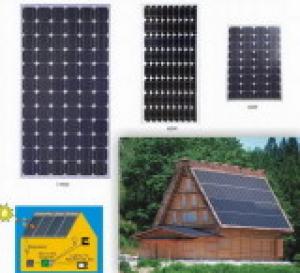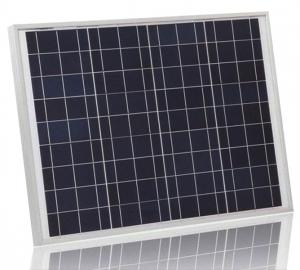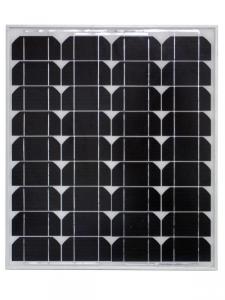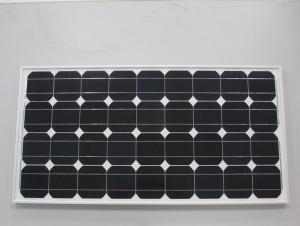80W Polycrystalline Solar Module for Barn - Mono and Poly CNBM
- Loading Port:
- Shanghai
- Payment Terms:
- TT or LC
- Min Order Qty:
- 1 watt
- Supply Capability:
- 999999 watt/month
OKorder Service Pledge
OKorder Financial Service
You Might Also Like
Descrition:
Polycrystalline silicon photovoltaic products
There are nearly 20 kinds of current polysilicon component blue sky sunproduction, power ranging from 45W to 300W, details please refer toannex "polysilicon component parameter table".
The products have obtained CE certification, CQC certification, TUV certification.
In an advanced mode for management and a strict following to the 5S management rules, the company would like to create a clean and beautiful environment for production, in the main line of “tidying, regulating, clearing, cleaning, and accomplishment”, thus improving efficiency, leading to a canonical management and an excellent quality of products .
Good Quality 185W Solar Panel | |
Peak Power-Pmax(W) | 185W |
Open Circuit Voltage-Voc(V) | 44.2 |
Maximum Power Voltage-Vmp(V) | 36 |
Short Circuit Current-Isc(A) | 5.4 |
Maximum Power Current-Imp(A) | 5 |
Maximum System Voltage | 1000V DC |
Maximum Series Fuse Rating | 10A |
Power Tolerance | -1~+3% |
Temperature Coefficients of Pmax | -0.45%/℃ |
Temperature Coefficients of Voc | -0.348%/℃ |
Temperature Coefficients of Isc | 0.031%/℃ |
Nominal Operating Cell Temperature | 44.5±2℃ |
Standard Testing Condition(STC) | Irradiance:1000W/m²;Temperature:25℃;AM=1.5 |
Qualification Test Parameters | |
Operating Temperature | -40℃~+85℃ |
Storage Temperature | -40℃~+85℃ |
Pressure Bearing | ≥5400Pascal/m² |
Wind Bearing | ≥5400Pascal/m² |
Mechanical Characteristics | |
Cell Size | Mono 125*125mm±0.5 |
No.of Cells | 72pcs(6*12) |
Dimension | 1580*808*40mm |
Weight | 15.5Kg |
Glass | 3.2mm High Transmission,Low Iron |
Frame | Anodized Aluminum Alloy |
Junction Box | IP65Rated |
Internal Diodes | 3 Bypass Diodes |
Cable | 1*4.0mm² Length 900mm |
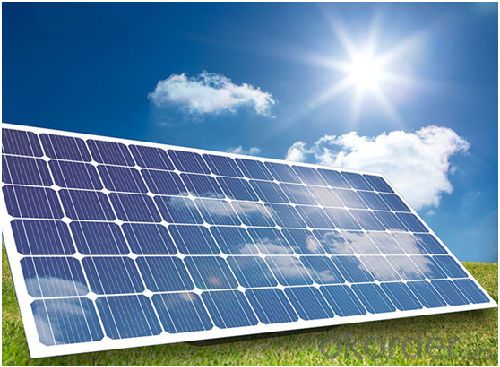
FAQ:
Do you have the CE, TUV, UL Certification?
We’ve already passed all the tests, and any certificate is available.
- Q: How do solar panels reduce carbon emissions?
- Solar panels reduce carbon emissions by generating electricity from sunlight, which is a clean and renewable energy source. Unlike fossil fuels, solar power does not produce any greenhouse gas emissions or pollutants during operation. By replacing traditional energy sources, such as coal or gas-fired power plants, with solar panels, we can significantly reduce the amount of carbon dioxide and other harmful emissions that are released into the atmosphere, helping to mitigate climate change and improve air quality.
- Q: How do solar panels interact with the electrical grid?
- Solar panels interact with the electrical grid through a process called net metering. When solar panels produce more electricity than is being used, the excess power is sent back to the grid, and the owner is credited for the energy produced. Conversely, when solar panels don't generate enough electricity, energy is pulled from the grid to meet the demand. This bidirectional flow enables solar panel owners to offset their energy usage and contribute to the overall energy supply.
- Q: What in the solar panel wares out so that the panel can not convert the suns energy to electric energy? Please post were you get answers.
- The plastic covering degrades slowly and becomes more opaque, The metal current carrying parts corrodes over time. The metal frames corrode but can be repaired. The photovoltaic cells also degrade over time from exposure to ozone and heat that builds up in the panel.
- Q: Can solar panels be used for powering Wi-Fi networks?
- Yes, solar panels can be used to power Wi-Fi networks. Solar panels generate electricity from sunlight, which can be used to power various devices, including Wi-Fi routers. This allows for the establishment of Wi-Fi networks in remote or off-grid locations where traditional power sources are either unavailable or unreliable. Additionally, solar-powered Wi-Fi networks are environmentally friendly and sustainable, as they utilize renewable energy sources.
- Q: Can solar panels be used in areas with high levels of electromagnetic radiation?
- Yes, solar panels can be used in areas with high levels of electromagnetic radiation. However, it is important to ensure that the panels are properly shielded and grounded to minimize any potential interference or damage caused by the electromagnetic radiation.
- Q: How do solar panels affect satellite dish reception?
- Solar panels can potentially interfere with satellite dish reception if they obstruct the line of sight between the dish and the satellite. However, modern satellite technology and proper positioning of both the panels and the dish can often mitigate any negative impact on reception.
- Q: Can solar panels be installed on remote or off-grid locations?
- Yes, solar panels can be installed on remote or off-grid locations. In fact, they are particularly suitable for such locations as they do not require a connection to the traditional power grid. Solar panels can generate electricity by harnessing sunlight, making them a reliable and sustainable energy source for remote areas.
- Q: but is that per day, per hour or minute?How much watts does the average AC unit use?How much does an energy efficient lightbulb use?All in all let's hypothetically say we no longer use the electric company for our energy source, How many of these panels do you estimate it would take to supply our small home?
- The watt is a measure of instantaneous output that can also be used as an hourly measure. volt at amp for hour = watt but also a 00watt bulb requires a 00watt power source, regardless of how long it is on, the 00watts is used as an instantaneous term here. Aircon starts at about 000watts and the new energy efficient bulbs are about 7-5 watts. If you have an electric cooker, that might use 3000 watts, your computer about 500 (very variabke these days though, many are now much lower than this) Your biggest concern would be storage, solar only works when the sun shines so you need a bank of batteries to charge during the day and provide power on demand, they require proper managenemt to ensure ther are charged properly and in turn, an inverter will be required to produce the AC power your appliances will need. It all represents a huge investment with a long payback time and you would still probably need to top-up with a generator during winter, or become ahmish.
- Q: I live in the UK, I have no savings (so would have to take out a loan of about ?8000), I don't know how long I plan to stay in my house, I might want to move in a year or two to take advantage of a better job so I want to keep the option open of being able to sell my house without having to pay off the cost of having the panels fitted (which I probably won't get back on the increased value they add to my house).What are the main advantages of having solar panels?What are the pitfalls the ever so eager cold callers with quotas to fill don't tell you about?Basically is it worth having them?Thankyou.
- If you're talking about photovoltaic panels, for making electricity, they're very expensive. Around here I think it runs around 2 bucks a watt of capacity, just for the panels. Then they have to be installed of course, which means an electrician has to be paid, and you need an inverter also. You can also spring for a bank of deep cycle batteries if you want to be able to store the electricity from the panels to use at night or on cloudy days, but that adds another very large expense. Now if electricity is very, very expensive where you are, you could maybe pay this off in a few years, but I doubt you could pay off 8000 pounds worth of this stuff in only a couple years. If you're talking about solar for water or air heating, well, that's another deal. But those kind of setups cost a lot less to put in, I can't see anyone paying that much for it.
- Q: How do you know when it is a good deal to buy a solar panel. For example, what is a good cost per watt, how many volts should I expect, etc.
- first okorder / example: house roof is 20' x 20' 20' = 240, so sq. inches of roof is = 57,600 say rain fall for your area is 3 per month on average. 57,600 x 3 = 72,800 of rain collected. Using the conversion chart link above, that many cubic inches of water = 750 gallons of water free per month. Look at your water bill and see how much you use. Solar panels take on average 2-20 yrs to pay themselves off, just in time for them to be replaced. Paddle wheels go on for just about forever. We still find large paddle wheel mills in the USA that are over 200 yrs old, and still functioning.
Send your message to us
80W Polycrystalline Solar Module for Barn - Mono and Poly CNBM
- Loading Port:
- Shanghai
- Payment Terms:
- TT or LC
- Min Order Qty:
- 1 watt
- Supply Capability:
- 999999 watt/month
OKorder Service Pledge
OKorder Financial Service
Similar products
Hot products
Hot Searches
Related keywords
